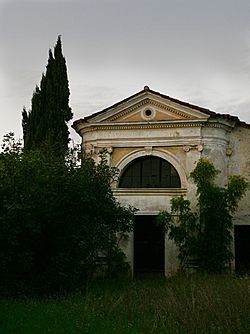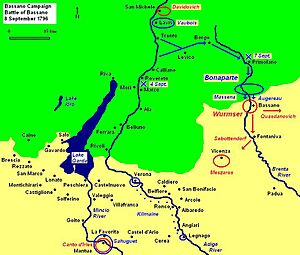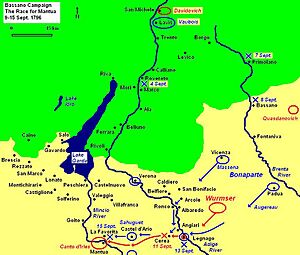Battle of Bassano facts for kids
Quick facts for kids Battle of Bassano |
|||||||
|---|---|---|---|---|---|---|---|
| Part of the French Revolutionary Wars | |||||||
 The church of San Giovanni on the outskirts of Bassano, Bonaparte's headquarters during the battle |
|||||||
|
|||||||
| Belligerents | |||||||
| Commanders and leaders | |||||||
|
|
|||||||
| Strength | |||||||
| 20,000 | 20,000 | ||||||
| Casualties and losses | |||||||
| 400 killed, wounded or missing | 600 killed or wounded, 6,000 captured, 30 cannons, 8 standards |
||||||
The Battle of Bassano was a major fight on September 8, 1796. It happened during the French Revolutionary Wars in what is now Italy. The battle was between a French army led by Napoleon Bonaparte and Austrian forces under Count Dagobert Sigmund von Wurmser.
This battle was part of the second time the Austrians tried to break the siege of Mantua. The French won, but it was one of Napoleon's last big victories for a while. The Austrians lost many supplies, cannons, and flags.
Contents
Why Did the Battle of Bassano Happen?
Austrian Plans to Help Mantua
The city of Mantua was under siege by the French army. The first attempt by the Austrians to help Mantua failed in early August. This led to battles like Lonato and Castiglione. After these defeats, the Austrian commander, Wurmser, had to retreat north. The French then continued their siege of Mantua.
Emperor Francis II ordered Wurmser to try again to help Mantua. Wurmser and his new chief of staff, Franz von Lauer, made a plan. They left 13,700 soldiers to protect Trento and the area around Tyrol. Wurmser then took two divisions of soldiers east and south. His goal was to meet another large division at Bassano. This would give him 20,000 men.
From Bassano, Wurmser planned to march to Mantua. Meanwhile, the other Austrian force would check French defenses from the north. The Austrians thought the French would be too weak to react quickly. However, the French government wanted Napoleon to cross the Alps. They wanted him to join another French army in southern Germany.
Important Routes and French Positions
In 1796, there were only three main roads between Trento and the Po River area. One road was west of Lake Garda. Another was along the Adige River valley, east of Lake Garda. The third road went east through Levico Terme and Borgo Valsugana. It then followed the Brenta River valley south to Bassano del Grappa. An army holding both Trento and Bassano could move troops easily.
Napoleon had placed his troops carefully. General of Division Claude Vaubois had 10,000 men west of Lake Garda. André Masséna defended the Adige River valley with 13,000 soldiers. Pierre Augereau protected Verona with 10,000 more. Charles Kilmaine kept up the siege of Mantua. He had 8,000 soldiers and a 2,000-man reserve.
How Napoleon Reacted
After the Battle of Castiglione, Napoleon improved his spy network. He learned that Wurmser had left some troops at Trento. So, Napoleon decided to attack first. He sent Masséna and Augereau north towards Trento. Vaubois also moved towards Riva at the north end of Lake Garda.
Vaubois and Masséna met at Rovereto on the Adige River. At the Battle of Rovereto on September 4, the French easily defeated the Austrian troops. The Austrians lost 3,000 soldiers, while the French lost 750.
When Napoleon found out Wurmser was moving towards Bassano, he changed his plan. He decided not to join the other French army in Germany. Instead, he took a big risk. He cut off his own supply lines. He ordered Augereau, followed by Masséna, to move east into the Brenta valley.
On September 7, Augereau's 8,200 soldiers attacked Wurmser's rear guard. This happened at Primolano, north of Cismon del Grappa. The French captured 1,500 men and their commander. The French then followed the valley south towards Bassano.
The Battle of Bassano
Fighting in Bassano
Even though the French advanced very quickly, Wurmser had gathered 20,000 men. On September 8, 20,000 French soldiers attacked Wurmser from the north. They first attacked the Austrian rear guard of 3,800 men.
Napoleon sent Masséna down the west side of the Brenta River. Augereau went down the east side. The Austrian rear guard was overwhelmed by repeated attacks. They were also chased by Colonel Joachim Murat's cavalry. The Austrian defense broke, and one of their generals was captured.
Wurmser had placed his troops in Bassano. Colonel Jean Lannes led a successful charge that broke the Austrian lines. The French burst into the town. Some defeated Austrians retreated east. But 3,500 soldiers fell back to the south with their commander.
The French had about 400 soldiers killed, wounded, or missing. The Austrians lost 600 killed or wounded. Between 2,000 and 6,000 Austrian soldiers were captured. The French also took eight flags and 30 cannons. They also seized many supply wagons.
The Race to Mantua
After the battle, Wurmser unexpectedly headed west towards Mantua. He joined another Austrian division at Vicenza. Napoleon immediately sent his two divisions after the Austrians. He hoped to cut them off. Masséna moved southwest from Vicenza. Augereau went south to Padua to block the Austrian escape route to the east.
An Austrian general, Peter Ott, bravely led Wurmser's advance guard in the race to Mantua. A French group holding Legnago left their post. This allowed the Austrians to cross the Adige River. Wurmser left 1,600 men to hold Legnago and kept marching.
On September 11, Masséna caught up with the Austrians at Cerea. His brigades were weakened by soldiers falling behind. Ott held them off until Wurmser arrived with his main army. The French were pushed back, losing 1,200 soldiers.
Napoleon ordered his troops to block the Austrians at Castel d'Ario and Governolo. The next day, Wurmser, helped by a local guide, crossed a bridge the French failed to destroy. He led 10,000 infantry and 3,000 cavalry to Mantua.
What Happened Next?
After capturing the Austrian group at Legnago on September 13, Napoleon arrived near Mantua. On September 15, Wurmser waited for the French outside Mantua. He had his army ready for battle.
The Austrian left side held off French attacks all day. But the Austrian line eventually broke. The French captured a suburb and pushed the Austrians into Mantua. In this fight, 2,500 Austrians were injured or captured. The French also took 11 cannons and 3 flags. The French lost 1,500 soldiers.
Mantua's garrison (the soldiers defending it) grew to almost 30,000 men. However, within six weeks, many Austrian soldiers died from injuries or sickness in the crowded fortress.
The second attempt to help Mantua did not go well for the Austrians. Their army commander, Wurmser, ended up trapped inside the very city he was trying to free. He lost over 11,000 men in the process. The French had not managed to connect their armies in Italy and Germany. Napoleon was back to facing the problem of taking Mantua, which now had a much stronger defense.
|




